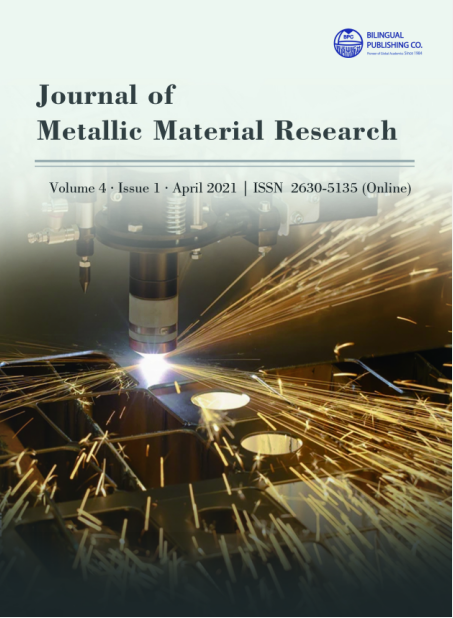-
11284
-
831
-
742
-
509
-
481
Identification of an Appropriate Formulation for Domestic Water Ceramic Filters from Soukamna Clay (Cameroon)
DOI:
https://doi.org/10.30564/jmmr.v4i1.3462Abstract
This paper deals with the formulation of ceramic filters having the porosity adapted to domestic potable water treatment. The filters were made from clays and rice husk obtained from the Far North region of Cameroon (Logone Valley). Nine formulations were investigated to choose those that might have the porosity standing between 35 and 50% (the ideal porosity adapted for water treatment) [1]. The nine formulations investigated were as follow: clay:rice husk mixture weight ratio 0.7:0.3; 0.8:0.2 and 0.9:0.1 with the particle size of 100:100 microns. The sintering temperatures of 900°C, 950°C and 1000°C were applied for each of the mixtures. The results showed that only filters with weight ratio 0.7:0.3 sintered at 900°C, 950°C and 1000°C had porosity between 35 and 50% with values of 39.41±0.96; 40.15±1.59; 40.14±1.31 respectively. Mechanical strength, permeability and iron leaching behavior were investigated for these three formulations. The formulation 0.7:0.3 with sintering temperature of 1000°C had the higher permeability and was the more stable for iron leaching so it is the more adapted for water treatment in terms of flow rate and iron leaching behavior, pore size distribution showed that these filters were macroporous and designed for microfiltration with average pore diameter of 0.46µm.
Keywords:
Ceramic filter, Porosity, Permeability, Iron leaching, SoukamnaReferences
[1] Yakub I., Du J., Soboyejo W.O. Mechanical properties, modeling and design of porous clay ceramics [C]. Material Science and Engineering A, 558, 21-29.
[2] Van Halem D., Van Der Laan H., Soppe A.I.A. and Heijman S.G.J. High flow ceramic pot filters [C]. Water Research, 124, 398-406.
[3] Zereffa Enyew Amare and Bekalo Tesfaye Betela. Clay Ceramic Filter for Water Treatment [C]. Journal of Materials Science and Applied Chemistry, 34, 69-74.
[4] Salvinelli C.J. and Elmore A.C. Assessment of the impact of water parameters on the flow rate of ceramic pot filters in a long-term experiment [C]. Journal Water Science and Technology: Water Supply, 15, 6, 1425–1432. ( https://doi.org/10.2166/ws.2015.107 ).
[5] Khandan A., Karamian E., Mehdikhani-Nahrkhalaji M., Mirmohammadi H., Farzadi A., Ozada N., Heidarshenas B. and Zamani K. Influence of Spark Plasma Sintering and Baghdadite Powder on Mechanical Properties of Hydroxyapatite [C]. Procedia Materials Science, 11, 183-189.
[6] Karimizade A., Takallu S. and Mirzaei E. Evaluating the effect of pH on mechanical strength and cell compatibility of nanostructured collagen hydrogel by the plastic compression method [C]. Nanomedicine, 5, 3, 180-185.
[7] Barbato N. Carla, Nele Marcio, Pinto C. José et Silvia C. A. França. Studies of Kaolin Rheology [C]. IX JATRAMI, San Juan, Argentina, 2008, 2-11.
[8] Ayadi Afef Jmal, Soro Julien, Kamoun Amel et Baklouti Samir. Study Of Clay’s Mineralogy Effect On Rheological Behavior Of Ceramic Suspensions Using An Experimental Design [C]. International Journal of Research and Reviews in Applied sciences, 14, 2, 374-384.
[9] Zghal H. Baccour, Medhioub M. et Mhiri T. Caractérisation physicochimique et mécanique de matériaux céramiques obtenus à partir des argiles Tunisiennes [C]. Verres, Céramiques & Composites, 1, 2, 25-33.
[10] Nasir Nurulfazielah, Ridhwan Jumaidin, Mohd Zulkefli Selamat, Suhaila Salleh et Kok-Tee Lau. Effect of Different Types of Pore-Forming Agent on the Macro Pore Size of Ceramic [C]. Applied Mechanics and Materials, 761, 380-384.
[11] Al Zubaidy R.Z., Al-Khafaji M.S. and Al-Saadi R.J.M. Compatibility between Hydraulic and Mechanical Properties of Ceramic Water Filters [C]. Journal of Engineering, 23, 147-167.
[12] Dabare L. and Svinka R. Characterization of Porous Ceramic Pellets from Latvian Clays [C]. Chemija, 25, 82-88.
[13] Hettiarachchi P., Motha J.T.S. and Pitawala H.M.T.G.A. Identification of an appropriate body composition for red clay products [C]. Cerâmica 56, 339, 285-290.
[14] Ali Mohammed Sabah, Azmah Hanim Mohamed Ariff, Che Nor Aiza Jaafar, Suraya Mohd Tahir, Norkhairunnisa Mazlan, and Khamirul Amin Maori. Factors Affecting the Porosity and Mechanical Properties of Porous Ceramic Composite Materials [C]. Materials Science and Materials Engineering. Oxford: Elsevier; 2017, 1-54.
[15] Erhuanga Ebele, Isah Bolaji Kashim and Tolulope Lawrence Akinbogun. Development of Ceramic Filters for Household Water Treatment in Nigeria [C]. Art and Design Review, 2, 6-10.
[16] Borra Chenna Rao, Mermans Jasper, Blanpain Bart, Pontikes Yiannis, Binnemans Koen and Van Gerven Tom. Selective recovery of rare earths from bauxite residue by combination of sulfation, roasting and leaching [C]. Journal of Minerals Engineering, 92, 151-159.
[17] Bennour A., Mahmoudi S., Srasra E., Boussen S. and Htira N. Composition, firing behavior and ceramic properties of the Sejnène clays (Northwest Tunisia) [C]. Applied Clay Science, 115, 30–38.
[18] Biron Dionisio da Silva, Bortoluz Jordana, Mara Zeni, Bergmann C. P. and Venina dos Santos. Characterization of Mullite Ceramic Membranes and their Application in the Removal Escherichia Coli [C]. Materials Research, 19, 513-519.
[19] Sotomayor J. Francisco, Katie A. Cychosz and Matthias Thommes. Characterization of Micro/Mesoporous Materials by Physisorption: Concepts and Case Studies [C]. Accounts of Materials & Surface Research, 3, 34-50.
Downloads
How to Cite
Issue
Article Type
License
Copyright © 2021 Nguiamba Ngiongboung

This is an open access article under the Creative Commons Attribution-NonCommercial 4.0 International (CC BY-NC 4.0) License.




 Ngiongboung Nguiamba
Ngiongboung Nguiamba





